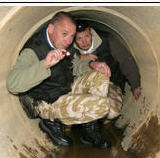Apt 5J: What 'Q' says about the GNR Search and Rescue Dogs
The Complete Mystery of Madeleine McCann™ :: The Complete Mystery of Madeleine McCann™ forum :: CMOMM & MMRG - 10 Years On! :: The accomplishments of CMOMM and its members :: Articles :: The Madeleine McCann Research Group
Page 1 of 1 • Share
 Apt 5J: What 'Q' says about the GNR Search and Rescue Dogs
Apt 5J: What 'Q' says about the GNR Search and Rescue Dogs
This article was originally brought to CMOMM by the Madeleine Foundation (MF) on 18 November 2011.
'Q' is someone who kindly presented a paper at an MF regional conference.
We have his permission to put forward this paper of his below for discussion:
++++++++++++++++++++++++++++++++++++++
DOGS DETECTION OF CADAVERINE
I’d like to dispel a few myths about EVRD’s (Enhanced Victim Recovery Dogs) .
In trials the shortest post-mortem interval where a correct response was received is one hour and 25 minutes. These results were from tests done using cloth which had been placed on a body for specific times which trained cadaver dogs then located.
There has to be a difference in using 2inch pieces of cloth that have been exposed to a body compared to that of a complete human body still decomposing and producing cadaverine or cadaver residue left behind as a result of a body contaminating an area.
At the time of biological death, the individual scent emitted by someone undergoes a transformation. This change is not immediately detectable by humans, but it is known to affect the composition of the odour detected by the dog and the dogs resulting behaviour.
In order to understand the type of scent available to the dog it is important to learn about the stages of decomposition.
The decomposition process commences immediately after biological death occurs and proceeds through five stages before the body is completely skeletonized.
The first stage of decomposition is called the ‘Fresh’ stage . There is little or no exterior change to the body, however, it is decomposing inside due to internal bacteria. No odour is detectable by humans at this stage; however dogs may show reaction or approach the body/scent as if it were still alive and they can detect the scent at this stage at some distance - ( this means the scent is leaving the body and residue is being omitted ).
Dogs are trained to react to the scent picture through the complete spectrum .
Decomposition begins within 5-15 minutes 5-15 approx., depending on environmental conditions, of someone dying (clinical death) when protein synthesis in the body stops. With nothing to maintain the protective lining in the gut, digestive enzymes eat the body from the inside out creating amino acids. While this is happening bacteria feed on those amino acids. This process produces chemicals such as ammonia and ptomaines (one commonly known as cavaderine) and that is one of the scents the EVRD is trained to detect.
If residue from a decomposing body was located in that spot and one of the most experienced and well paid dogs in the entire world signalled to blood in the exact same spot, then there had to have been cadaver residue & blood there .
According to Martin Grime’s, cross contamination is immediate; once someone dies and their body begins decomposing it is possible that the objects, area and people that make contact with that body can become contaminated with cadaver residue: these areas are hence ‘cross contaminated’ – the body being the original source .
They were not brought in by the British & Portuguese authorities to look for an abducted child, they were looking for evidence of accidental or non-accidental death because that is what they suspected happened given the circumstances and other evidence which pointed to that scenario.
Tests have proven that residual scent from a cadaver will last in a building with minimum environmental influences or human disturbance for at least 1 Year, even after the objects where the scent source originated had been removed .
Re the GNR Tracker Dogs & Search & Rescue Dogs
Dogs use their natural ability and hunting instinct to find scents and their ability to do this is nearly impossible to defeat. They can locate a scent no matter how much it is intermingled with other odours and dependant on environmental conditions, can detect that scent when it is days old.
A phenomenon that has been noted by many trainers/dog handlers is that some dogs will follow a trail, often many days old, but fail to close in on a body if the subjects is deceased. They may register the scent change - but whether from fear, difference in odour, or some other reason. may not approach the body.
In reality, the dog is showing an aversion to cadaver scent . The dog may show aversion by raising its hackles, circling, or other behaviour, that indicates that it may not want to approach an area appears to be confused..
This could I think certainly apply to trained tracker dogs not experienced or trained in finding dead bodies, such as the dogs deployed by both the GNR and the two Search & Rescue Dogs (S & R dogs specifically trained to find humans) brought in on the 4th May. This could be an explanation as to why they appeared to be distracted at the door of Apt.5J when following the same scent trail.
This was put down to waste foodstuffs, something I doubt very much, given the S&R Dogs are trained scent discrimination dogs. The search and rescue dogs and teams, as stated, are trained to find human scent and have to regularly meet certain standards and tests done to prove their competence.
I know there has been a lot of discussion suggesting Apt 5J may have been used as a location to store the body and we know the dogs stopped and were distracted there before continuing there tracking to the car park area .
At least 3 or 4 dogs all independently followed almost exactly the same scent trail . The Target Scent used by the Search & Rescue dogs was a blanket belonging to M. , I'm not certain what the GNR dogs used without checking but I think a towel.
It would have to be sheer fluke for all the dogs to independently follow the same trail at different times, the odds ratio of this happening given the variants are too great and the fact different dogs followed the same trail at different times reinforces the idea that this scent trail had to be the strongest / most recent.
This leads me to think that Apt 5J may have been used as a temporary place to hide the body and that the dogs were distracted / confused by the scent of cadaverine which would have ' built up ' inside that apartment and not foodstuffs as suggested , until they picked up the original scent trail again leading them to the car park area.
If the body wasn’t put into a freezer there it was only temporary so would not have frozen properly , possibly only cold storage until it was moved shortly after. My reasoning behind this is the scent trail leading from Apt 5J to the car park , I doubt very much there would have been any scent trail to follow from a frozen body.
by 'Q', 2011
------------
For discussion, please visit this thread: https://jillhavern.forumotion.net/t3888-apt-5j-what-q-says-about-the-gnr-search-and-rescue-dogs
'Q' is someone who kindly presented a paper at an MF regional conference.
We have his permission to put forward this paper of his below for discussion:
++++++++++++++++++++++++++++++++++++++
DOGS DETECTION OF CADAVERINE
I’d like to dispel a few myths about EVRD’s (Enhanced Victim Recovery Dogs) .
In trials the shortest post-mortem interval where a correct response was received is one hour and 25 minutes. These results were from tests done using cloth which had been placed on a body for specific times which trained cadaver dogs then located.
There has to be a difference in using 2inch pieces of cloth that have been exposed to a body compared to that of a complete human body still decomposing and producing cadaverine or cadaver residue left behind as a result of a body contaminating an area.
At the time of biological death, the individual scent emitted by someone undergoes a transformation. This change is not immediately detectable by humans, but it is known to affect the composition of the odour detected by the dog and the dogs resulting behaviour.
In order to understand the type of scent available to the dog it is important to learn about the stages of decomposition.
The decomposition process commences immediately after biological death occurs and proceeds through five stages before the body is completely skeletonized.
The first stage of decomposition is called the ‘Fresh’ stage . There is little or no exterior change to the body, however, it is decomposing inside due to internal bacteria. No odour is detectable by humans at this stage; however dogs may show reaction or approach the body/scent as if it were still alive and they can detect the scent at this stage at some distance - ( this means the scent is leaving the body and residue is being omitted ).
Dogs are trained to react to the scent picture through the complete spectrum .
Decomposition begins within 5-15 minutes 5-15 approx., depending on environmental conditions, of someone dying (clinical death) when protein synthesis in the body stops. With nothing to maintain the protective lining in the gut, digestive enzymes eat the body from the inside out creating amino acids. While this is happening bacteria feed on those amino acids. This process produces chemicals such as ammonia and ptomaines (one commonly known as cavaderine) and that is one of the scents the EVRD is trained to detect.
If residue from a decomposing body was located in that spot and one of the most experienced and well paid dogs in the entire world signalled to blood in the exact same spot, then there had to have been cadaver residue & blood there .
According to Martin Grime’s, cross contamination is immediate; once someone dies and their body begins decomposing it is possible that the objects, area and people that make contact with that body can become contaminated with cadaver residue: these areas are hence ‘cross contaminated’ – the body being the original source .
They were not brought in by the British & Portuguese authorities to look for an abducted child, they were looking for evidence of accidental or non-accidental death because that is what they suspected happened given the circumstances and other evidence which pointed to that scenario.
Tests have proven that residual scent from a cadaver will last in a building with minimum environmental influences or human disturbance for at least 1 Year, even after the objects where the scent source originated had been removed .
Re the GNR Tracker Dogs & Search & Rescue Dogs
Dogs use their natural ability and hunting instinct to find scents and their ability to do this is nearly impossible to defeat. They can locate a scent no matter how much it is intermingled with other odours and dependant on environmental conditions, can detect that scent when it is days old.
A phenomenon that has been noted by many trainers/dog handlers is that some dogs will follow a trail, often many days old, but fail to close in on a body if the subjects is deceased. They may register the scent change - but whether from fear, difference in odour, or some other reason. may not approach the body.
In reality, the dog is showing an aversion to cadaver scent . The dog may show aversion by raising its hackles, circling, or other behaviour, that indicates that it may not want to approach an area appears to be confused..
This could I think certainly apply to trained tracker dogs not experienced or trained in finding dead bodies, such as the dogs deployed by both the GNR and the two Search & Rescue Dogs (S & R dogs specifically trained to find humans) brought in on the 4th May. This could be an explanation as to why they appeared to be distracted at the door of Apt.5J when following the same scent trail.
This was put down to waste foodstuffs, something I doubt very much, given the S&R Dogs are trained scent discrimination dogs. The search and rescue dogs and teams, as stated, are trained to find human scent and have to regularly meet certain standards and tests done to prove their competence.
I know there has been a lot of discussion suggesting Apt 5J may have been used as a location to store the body and we know the dogs stopped and were distracted there before continuing there tracking to the car park area .
At least 3 or 4 dogs all independently followed almost exactly the same scent trail . The Target Scent used by the Search & Rescue dogs was a blanket belonging to M. , I'm not certain what the GNR dogs used without checking but I think a towel.
It would have to be sheer fluke for all the dogs to independently follow the same trail at different times, the odds ratio of this happening given the variants are too great and the fact different dogs followed the same trail at different times reinforces the idea that this scent trail had to be the strongest / most recent.
This leads me to think that Apt 5J may have been used as a temporary place to hide the body and that the dogs were distracted / confused by the scent of cadaverine which would have ' built up ' inside that apartment and not foodstuffs as suggested , until they picked up the original scent trail again leading them to the car park area.
If the body wasn’t put into a freezer there it was only temporary so would not have frozen properly , possibly only cold storage until it was moved shortly after. My reasoning behind this is the scent trail leading from Apt 5J to the car park , I doubt very much there would have been any scent trail to follow from a frozen body.
by 'Q', 2011
------------
For discussion, please visit this thread: https://jillhavern.forumotion.net/t3888-apt-5j-what-q-says-about-the-gnr-search-and-rescue-dogs

Guest- Guest
 Similar topics
Similar topics» Apt 5J: What 'Q' says about the GNR Search and Rescue Dogs
» Those incredibly 'unreliable' DOGS............again!
» The discrepencies in the McCanns and cronies statements.
» Kate and Dogs - all sorts
» LISA IRWIN, 10 months: parents make tearful plea - AND - Aaliyah Lunsford, missing in U.S., aged 3: LATEST
» Those incredibly 'unreliable' DOGS............again!
» The discrepencies in the McCanns and cronies statements.
» Kate and Dogs - all sorts
» LISA IRWIN, 10 months: parents make tearful plea - AND - Aaliyah Lunsford, missing in U.S., aged 3: LATEST
The Complete Mystery of Madeleine McCann™ :: The Complete Mystery of Madeleine McCann™ forum :: CMOMM & MMRG - 10 Years On! :: The accomplishments of CMOMM and its members :: Articles :: The Madeleine McCann Research Group
Page 1 of 1
Permissions in this forum:
You cannot reply to topics in this forum





































